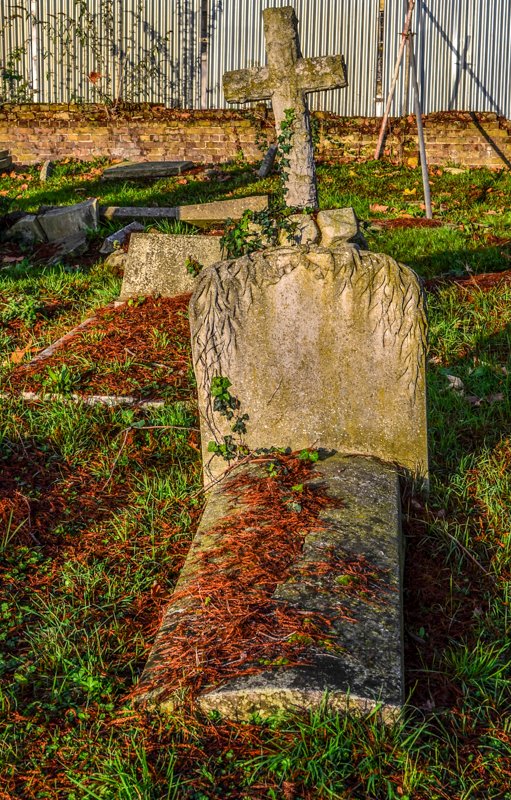
Kensal Green was the first of London's Victorian-era “magnificent seven“ garden cemeteries. Only three miles from Oxford Street on land purchased by the General Cemetery Company to set up a better place for “eternal sleep in grand surroundings”. London' practice of burying the dead in overcrowded churchyards was unhygienic and becoming impractical. It was also a way to make money for company and shareholders. As barrister George Carden said in the prospectus:-"To rob Death of its Terrors, and make it delightful".
Opened in 1833, the layout of Kensal Green, with its looping avenue walkways was based on the Napoleon founded Pere Lachaise cemetery in Paris. In my opinion Pere Lachaise is a much more interesting cemetery as it is more like a little city of mausoleum under shady trees. Plus the residents in Paris are more famous.
 Inside Kensal Green from the Harrow Road entrance
Inside Kensal Green from the Harrow Road entrance
On a chilly late-Autumn day I walked through the Doric arch entrance off Harrow Road. This open space, once full of grazing sheep, is now the final resting place over 250,000 people of all denominations of religion. Forever now neighbours including Royalty, titled nobility, artists, politicians, lawyers, doctors, scientists along with nonconformists, infidels and heretics.
Starting at the seven acre lawn of the Dissenters with the Dissenters Chapel to the left, the large expanse of leaning rectangular headstones crowd together. The grass is wet with dew and I was glad my hiking boots are waterproof. Looking down Central Avenue the headstone view changes with occasional graves are adorned with angels and obelisks.
 Looking towards the Dissenters Chapel tucked away in the East corner
Looking towards the Dissenters Chapel tucked away in the East corner
 One of my favourite headstones. Basic yet elegant with the vine look
One of my favourite headstones. Basic yet elegant with the vine look
Along the South Avenue with the gasworks in the background. Here shrapnel damage can be seen on some tombs from bombs dropped during the Blitz. As the bombs hit, human remains scattered around the lawn but reburied. Later on at the Anglican Chapel I see a memorial plaque for “those interred in this cemetery whose graves and monuments were totally destroyed by enemy action during the second world war 1939 – 1945”.
 South lawn and the gasworks over the Grand Union Canal and nearby railroads
South lawn and the gasworks over the Grand Union Canal and nearby railroads
Deeper into the cemetery mausoleums become more common then the average tombstone. Some are impressive with pink Peterhead granite with the occupants chiselled out epitaph. It seems attempting to out do each other in death. Such as the Andrew Ducrow (1793-1842) and his Egyptian themed crypt in the “Inner Circle”. The tomb is extremely fancy for a circus performer who wrestled lions and includes a pair of angels catching a crystal ball.
 Andrew Ducrow's elaborate tomb
Andrew Ducrow's elaborate tomb
 The crystal ball
The crystal ball
A short distance away the Doric Anglican Chapel dominates the centre of the cemetery. There are catacombs below, although only possible to visit during the annual “Day of the Dead” run by .the Friends of Kensal Green. An open day when you can also buy jams made from the berries grown in the cemetery.
 The Anglican Chapel
The Anglican Chapel
There are also catacombs North near the Kensal Green tube station inside a stately but run-down colonnade structure.
 Colonnade along the side of Harrow Road with catacombs
Colonnade along the side of Harrow Road with catacombs
Outside the Anglican Chapel, Royalty is represented by HRH Augustus Frederick, Duke of Sussex (1773-1843), sixth son of George III and his sister HRH Princess Sophia (1777-1848) plotted across from each other.
 Princess Sophia lays beneath a sarcophagus designed by Prince Albert architect Professor Ludwig Gruener
Princess Sophia lays beneath a sarcophagus designed by Prince Albert architect Professor Ludwig Gruener
There are a couple of other Dukes buried in the cemetery, along with Queen Victoria's staff members. Because this resting place was good enough for Royals, the more popular Kensal Green became.
At the back Kensal Green is the operating West London Crematorium where in recent times Ingrid Bergman, Freddie Mercury and Joe Strummer have been cremated but their remains are elsewhere and not in the cemetery.
The dead are still buried here in the limited space. Plots cannot be sold in advance and burial depends on time of asking upon death.
 Sir William Casement Casement (1778 – 1844) died from cholera in India is buried in Calcutta but this cenotaph in his memory was erected by his widow. A decorated Colonel and member of the Indian Supreme Council
Sir William Casement Casement (1778 – 1844) died from cholera in India is buried in Calcutta but this cenotaph in his memory was erected by his widow. A decorated Colonel and member of the Indian Supreme Council
Location:-
385 Ladbroke Grove, Kensal Green, Greater London W10 5JX
All photos taken by myself.
Hi! I am a robot. I just upvoted you! I found similar content that readers might be interested in:
https://dkjswalkabout.wordpress.com/2015/01/08/kensal-green-general-cemetery-for-all-souls-to-rob-death-of-its-terrors-and-make-it-delightful/
Downvoting a post can decrease pending rewards and make it less visible. Common reasons:
Submit
Thank you for your contribution to the Photocircle tag!
Cheers,
@Photocircle Team
Learn about this photo curation project by clicking >here
Downvoting a post can decrease pending rewards and make it less visible. Common reasons:
Submit
Congratulations, Your Post Has Been Added To The Steemit Worldmap!
Author link: http://steemitworldmap.com?author=izzynoel
Post link: http://steemitworldmap.com?post=kensal-green-general-cemetery-for-all-souls-to-rob-death-of-its-terrors-and-make-it-delightful
Want to have your post on the map too?
Downvoting a post can decrease pending rewards and make it less visible. Common reasons:
Submit